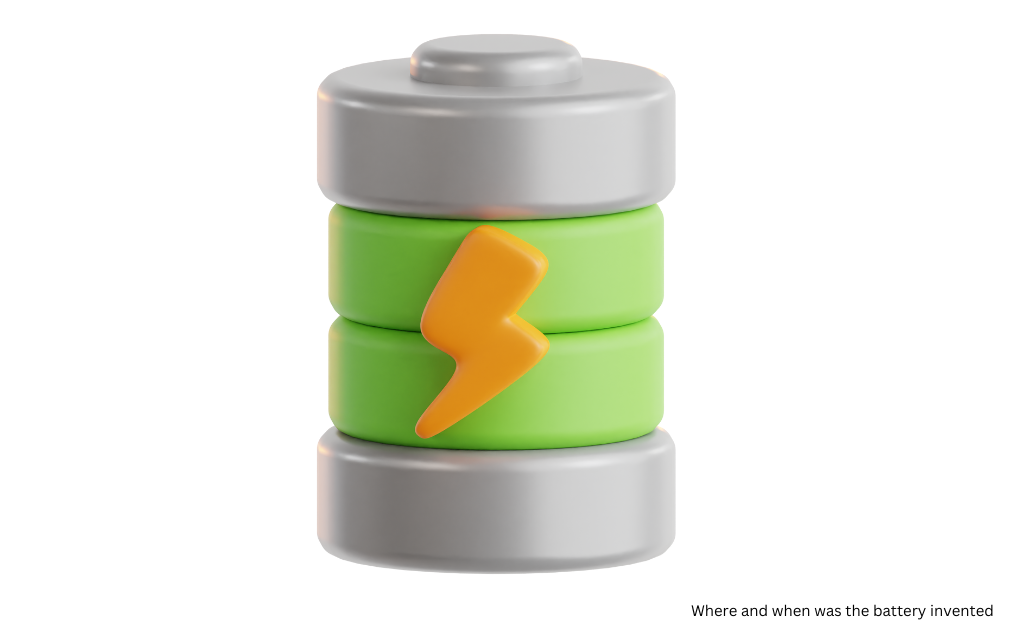Did you know that the first battery was invented over 200 years ago? Today, batteries power everything from smartphones to electric cars, but their journey began long before modern technology.
History about batteries remains unknown to numerous individuals. Who invented the first battery? Where did it happen? Which factors transformed the world because of this invention? Many seek information about the first battery to be invented and its creation context along with the worldwide impact.
In this post, you’ll discover the fascinating story behind the first battery, where and when it was invented, and how it shaped the future of electricity. By the end, you’ll have a clear understanding of its origins and why it remains one of the most important inventions in history.

How the First Battery Came to Life
Alessandro Volta the Italian scientist constructed the first authentic battery back in 1800. The device was not compact or modern in appearance like present-day batteries yet it delivered constant power production.
Before Volta’s invention, scientists had only seen brief sparks of electricity from experiments with static charges. But Volta wanted more. He wanted a way to produce electricity continuously.
The Voltaic Pile represented his creation which proved to be a basic yet effective electrical product. He combined zinc and copper discs which he separated with saltwater-soaked cloth. The layers within the device generated electrical current through their combined operation. A chemical connection between wire and battery resulted in the illumination of small devices and confirmed that electricity could be formed from chemical processes.
Volta’s discovery didn’t happen overnight. He built on the work of scientists like Luigi Galvani, who had experimented with frog legs and electrical currents. But unlike Galvani, Volta believed metal, not living tissue, created electricity. His experiments proved he was right.
This invention changed everything. It led to new discoveries in electricity, chemistry, and engineering. It also inspired future inventors to improve battery technology, shaping the modern world we live in today.
The First Battery: A Spark That Changed Everything
When Alessandro Volta built the first battery in 1800, he did more than create a new device—he opened the door to modern electricity. Scientists now had a steady source of electric power. This changed the way they studied energy, chemistry, and magnetism.
One of the biggest breakthroughs came from Michael Faraday, a young scientist in England. With Volta’s battery, Faraday discovered electromagnetism. His work later led to the invention of electric motors and generators. Without Volta’s invention, this progress might have taken decades longer.
The battery also had practical uses. It helped improve electroplating, a process where electricity coats metal with a thin layer of another metal. This was useful for making jewelry, coins, and tools. Another important use was in telegraphy. Early telegraph machines relied on batteries to send messages over long distances, changing communication forever.
Volta’s simple invention became the foundation for countless discoveries. It gave scientists the power to experiment, test, and build new technology. The world would never be the same again.
Did America Invent the Battery?
No, the first battery was not invented in America. It was created in Italy by Alessandro Volta in 1800. His Voltaic Pile was the first device to produce a steady electric current. However, America played a big role in the evolution of battery technology.
One of the earliest American contributions came from Benjamin Franklin. In the 1700s, he experimented with electricity and even coined the term “battery” to describe a group of charged glass plates. Although Franklin didn’t build a working battery, his research helped shape the study of electricity.
In the late 1800s, Thomas Edison worked on improving battery technology. He developed the nickel-iron battery, which was more durable than earlier designs. His invention was used in electric cars and industrial machines.
The biggest American breakthrough came in the 20th century. Scientists in the U.S. developed the lithium-ion battery, which now powers phones, laptops, and electric vehicles. This invention changed modern life and made portable electronics possible.
While the first battery was invented in Italy, America helped take battery technology to the next level.

How Batteries Changed Over Time
The invention of the battery was just the beginning. Over the years, scientists improved battery technology, making them more powerful, reliable, and reusable. Each new design brought the world closer to the advanced batteries we use today.
In 1836, John Daniell created the Daniell Cell, which solved a big problem. Earlier batteries lost power too quickly. His design used copper and zinc with a salt solution, making batteries last longer and work more consistently.
The next big step came in 1859 when Gaston Planté invented the lead-acid battery. This was the first rechargeable battery. It was strong enough to power early automobiles, laying the foundation for car batteries used today.
In 1899, Swedish scientist Waldemar Jungner introduced the nickel-cadmium (Ni-Cd) battery. Unlike earlier batteries, it could be recharged many times. This made it useful for portable electronics and power tools.
The biggest revolution came in the 1970s with the invention of the lithium-ion battery. These batteries are lightweight, rechargeable, and long-lasting. They power smartphones, laptops, and electric cars, shaping the modern world.
From simple chemical reactions to high-tech energy storage, batteries have come a long way. Each step has brought better performance, longer life, and greater convenience.
The Battery’s Journey: From Simple Stacks to Powering the Future
Modern batteries constitute significant progress from their original 1800 metal stacking concept. Since 1800 the initial arrangement of metals has evolved into an integral element of present-day existence. Technological progress among scientists led to advanced battery structures that provided stronger performance and longer-lasting capabilities and greater efficiency. The development of battery technology culminated in lithium-ion batteries by advancing from the original Daniell Cell design.
Without batteries, the world would look very different. Phones, laptops, electric cars, and even renewable energy systems all depend on them. They have made technology portable, sustainable, and more advanced than ever before.
But the journey isn’t over. Scientists are now working on faster-charging, longer-lasting, and eco-friendly batteries. The future may bring batteries that last for decades, charge in seconds, and store massive amounts of clean energy.
The question is no longer where and when was the battery invented—it’s how far can we take it next?

What is a Battery?
A battery is a device that stores and supplies electrical energy through chemical reactions. It consists of electrochemical cells that convert stored chemical energy into electricity. Batteries are classified into primary (non-rechargeable) and secondary (rechargeable) types, playing a crucial role in powering electronic devices, vehicles, and even large-scale energy grids.
The Future of Battery Technology
Sustainable and Eco-Friendly Batteries
With growing environmental concerns, scientists are working on biodegradable and recyclable batteries to reduce electronic waste. Advances in battery recycling technologies will also help minimize harmful chemical disposal.
The Role of Batteries in Renewable Energy
Batteries play a crucial role in storing renewable energy, such as solar and wind power, ensuring a stable and sustainable energy supply. Innovations in large-scale battery storage systems are paving the way for a greener future.
Conclusion
From Alessandro Volta’s first battery in 1800 to today’s high-tech lithium-ion and solid-state batteries, battery technology has come a long way. Innovations continue to shape our modern world, powering everything from smartphones to electric cars. As researchers work towards sustainable solutions, the future of batteries looks brighter than ever.
FAQs
1. Who invented the first battery?
The first practical battery was invented by Alessandro Volta in 1800. His Voltaic Pile was the first device capable of generating continuous electricity.
2. What was the Baghdad Battery used for?
The Baghdad Battery, discovered in Iraq, is believed to have been an ancient electrochemical device, but its true purpose remains uncertain. Some theories suggest it was used for electroplating or religious purposes.
3. Why are lithium-ion batteries so popular?
Lithium-ion batteries are lightweight, rechargeable, and have a high energy density, making them ideal for portable electronics and electric vehicles.
4. What are solid-state batteries?
Solid-state batteries use a solid electrolyte instead of liquid, offering improved safety, efficiency, and lifespan compared to traditional lithium-ion batteries.
5. What is the future of battery technology?
Future battery innovations focus on sustainability, efficiency, and renewable energy storage, with advancements in solid-state, sodium-ion, and biodegradable batteries leading the way.
